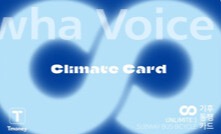
Starting Jan. 27, Seoul Metropolitan Government’s new Climate Card allows unlimited access to public transportation after a monthly payment of 62,000 to 65,000 won. The project aims to facilitate the usage of public transportation by alleviating citizens’ burden of transportation fees, which in effect is expected to reduce the amount of carbon emission.
The Climate Card is a project promoted by mayor of Seoul, Oh Se-hun, with the purpose of predicting and maintaining the number of public transport users. Since its release, it has been in high demand with over 330,000 cards being sold as of Feb. 14, according to the Seoul Metropolitan Government.
There are two ways in which people can use the Climate Card. One way is to download the Mobile T-money application and sign in, which enables people to use their Climate Cards from their mobile phones without paying additional fees. However, this method is unavailable for iPhone users, who must buy the card in person at nearby subway stations and convenience stores. After purchasing the card for 3,000 won, users can charge their card with cash.
People can choose to charge either 62,000 or 65,000 won depending on the extent of public transportation they wish to utilize. For those who only plan on using the bus and subway, the price is 62,000 won a month. For those who want to use the Seoul Bike as an addition, the monthly price is 65,000 won in total.
Another factor to consider is that certain stations are not considered “free” when using the Climate Card. Excluded sections are the Shinbundang Line, subway stations outside Seoul, buses that transcend cities or licensed in regions outside Seoul, and airport limousines. However, users can use the card for buses licensed in Seoul even if they leave the city. As for subways, users cannot use it if their destination is outside of Seoul, regardless of their destination. If they wish to do so, they can use the climate card, but are charged additional fees. According to Professor Min Baehyun from the Department of Climate and Energy Systems Engineering, the Climate Card project can be interpreted as a multi-objective system with three different objectives.
The first objective is to minimize the monthly price of the Climate Card, considering the satisfaction of customers and effects of the project. The second is to increase the rate of carbon emission reduction, and the third is to maximize the profitability of the card by adjusting the benefit-cost ratio.
Therefore, in order to find out how much the Climate Card contributes to vitalizing public transportation, it is necessary to find, design, and implement scenarios that can increase the benefits while lowering the cost, reducing carbon emission, and the price of monthly transit fees.
“It is necessary to improve the system by comparing and analyzing two theoretical figures — the figure expected when planning for the Climate Card and the actual figures after implementing it for several months,” Min commented. “Then you should correct the difference between these two figures.”
Jungyoon Choi, a sophomore from the Department of English Language and Literature, mentioned that she heard about the Climate Card through advertisements on the bus and subway. Even though she thought it would be beneficial to use the card, considering her monthly spending on transportation was around 156,000 won, buying the card was not the best option for her.
“As a commuter who lives outside of Seoul, I mostly use buses that transcend cities,” Choi mentioned. “However, I cannot use the Climate Card for such buses. If the card can only be used in Seoul, I do not think I will be purchasing it.”
On the contrary, Austin Worthington, an international student at Yonsei University, expressed his willingness to buy the card.
“Since my monthly spending for public transportation is around 110,000 won, I think using the card will be highly beneficial,” Worthington mentioned. “The Climate Card is useful because not only can you use it for buses and subways, but you can also use it for Seoul Bikes as well.”
The introduction of the Climate Card marks a significant step towards a greener society. As the business was implemented for less than a month, further actions to improve this business are still needed. Looking towards the future, it is imperative to monitor the progress of such ventures, ensuring that they continue to adapt and evolve in response to the public’s needs.

